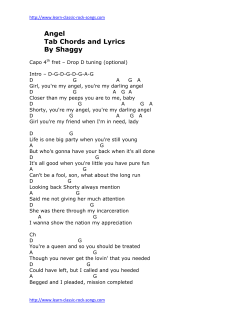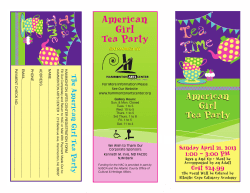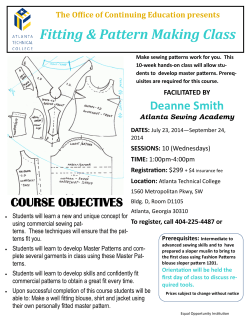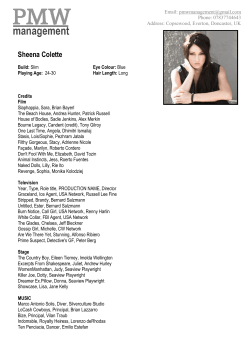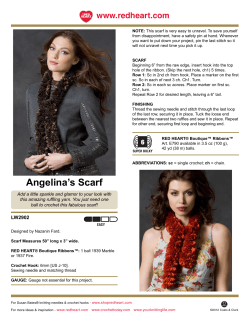
Guide Neckerchiefs, Scarves, and Ties Woggles and Tie Slides
Guide Neckerchiefs, Scarves, and Ties Woggles and Tie Slides 5601 North Allen Road Mableton, GA 30126 770-702-9100/1-800-771-4046 www.gsgatl.org October 2013 Volunteer Learning and Development In many countries, Girl Scouts and Girl Guides wear a scarf, or neckerchief (“necker”) with their uniform; in other countries, girls may wear a tie similar to a man’s tie, or a criss-cross tie similar to our Brownie tie. Girls might tie their scarf in a square knot or friendship knot, or use a woggle (tie slide) to hold the ends together. Magic Braid Woggle (directions below) Woggle crocheted from string Woggle made from Pony beads Turned wood woggle (bought in Switzerland.) Girl Scouts of Greater Atlanta – Knowledge Management – October 2013 2 Volunteer Learning and Development Some uses for a neckerchief (from the UK) Practically all of the different uses of a necker are because it is triangular: 1. Signal flag : tied to a stick and waved in the air, a brightly-coloured necker can be seen much more easily than just waving arms. 2. Blindfold for games - fold the necker in half lengthways (point to long edge) and then in half again and it will be long enough to tie round the head and also opaque enough to prevent anyone seeing through it. 3. Listed in old Scouting books is the "blindfold for a horse" - if you need to lead a horse out of (or into) somewhere it doesn't want to go, you will find it much easier if you blindfold it with your necker first! 4. Telling teams apart in games: if the players are all in the same unit and therefore wearing the same colour neckers, tie them in different ways: e.g. around the forehead; cowboy fashion, (with the broad part in front of the neck); Scout fashion, (broad part at the back); as a shoulder sash, (right or left shoulder) and on the right or left arm between the biceps and shoulder. 5. Tying anything to anything - roll or fold the necker along the longest edge to make a strong length of fabric. 6. Sun hat or anti-mosquito hood : tie a knot in the broad point and tie the long ends either under the chin or behind the head at the back of the neck. 7. Rescue lifeline: extend your reach for someone in the water using a necker; if necessary, tie neckers together point to point to make a longer lifeline. 8. Filter for muddy or oily water - boil it (the water!) after filtering it through a necker. 9. Emergency rope ladder : the broad parts of the neckers are looped together and tied with a square knot so that each one is a complete circle, making a chain (rather like a Christmas paper chain, only much stronger!) 10.First Aid - all the standard uses for a triangular bandage e.g. sling, head bandage (long edge to the forehead, letting the point fall to the back of the head and using the ends crossed in the back and tied in the front) foot/hand bandages, flat bandages (folded necker) and for tying and padding splints, etc. 11.Dust/insect cover for open food and/or drink. 12.A bag for carrying things (e.g. potatoes, apples, stuff collected in a scavenger hunt....): tie the three corners together and carry by the knot. 13.A folded necker can be used as padding for hand or shoulder when carrying heavy load Girl Scouts of Greater Atlanta – Knowledge Management – October 2013 3 Volunteer Learning and Development Girl Scouts of Greater Atlanta – Knowledge Management – October 2013 4 Volunteer Learning and Development How to Tie A Scarf Using the method of tying a reef/square knot. Step 1: Fold scarf a third of the way. Continue to fold/roll long edge over. Step 2: Place long edge around neck and tie reef knot. Step 3: Adjust scarf so that it is neat and tidy on both the front and back Girl Guides Singapore Girl Scouts of Greater Atlanta – Knowledge Management – October 2013 5 Volunteer Learning and Development Why use a woggle? The advantages of a woggle are that in hot weather and when hiking, the neckerchief (“necker,” “neckie”) can be loosened around the throat, while in a cold wind or bad weather it can be fastened up closer for warmth. When necessary to use the necker in emergencies (see below), the woggle can be quickly slid down and the necker can be whipped off over the head. When a woggle is not used a knot must be tied, and as it is unlikely to be tied twice alike nor at the same position, the necker collects creases, giving an untidy appearance. MAGIC BRAID WOGGLE Girl Scouts of Greater Atlanta – Knowledge Management – October 2013 6 Volunteer Learning and Development Girl Scouts of Greater Atlanta – Knowledge Management – October 2013 7 Volunteer Learning and Development Two-strand Turk's Head... .. three-strand Turk's Head... ...four-strand Turk's Head woggles, all made from plastic coated line How to crochet a woggle Using thin-ish string and a size 8 or 9 crochet hook, crochet a chain of 18, or however many you need with your string and hook to make a length 2½ inches long. Join in a circle with a slip-stitch. Crochet rounds of double crochet, being careful not to accidentally increase, until the woggle is the desired depth (mine took five rounds, but yours may require more or less depending on the thickness of the string and the size of hook used.) Fasten off with a slip-stitch. Cut off the remaining string, leaving an end about 4" long : thread this through a few times to fasten off then cut off the excess. Weave the starting end in in the same way. The Woggle looks different on the inside and outside - see which you prefer and turn it inside out if necessary. Girl Scouts of Greater Atlanta – Knowledge Management – October 2013 8 Volunteer Learning and Development SCARVES AROUND THE WORLD… Girl Scouts of the USA: Senior/Ambassador scarf; Brownie tie In the USA, the only girl members who have a scarf as part of their uniform are Girl Scout Seniors and Ambassadors; it is worn as a link with the WAGGGS tradition of neckerchiefs, scarves, and ties. Girl Scout Brownies have a tie they can wear with the blue shirt and brown skort uniform. Girl Scouts of Greater Atlanta – Knowledge Management – October 2013 9 Volunteer Learning and Development Argentina Bangledesh Girl Scouts of Greater Atlanta – Knowledge Management – October 2013 10 Volunteer Learning and Development Brazil Burundi Girl Scouts of Greater Atlanta – Knowledge Management – October 2013 11 Volunteer Learning and Development Cambodia Canada Girl Scouts of Greater Atlanta – Knowledge Management – October 2013 12 Volunteer Learning and Development Columbia Hong Kong Girl Scouts of Greater Atlanta – Knowledge Management – October 2013 13 Volunteer Learning and Development Germany Greece Girl Scouts of Greater Atlanta – Knowledge Management – October 2013 14 Volunteer Learning and Development El Salvador Kenya Girl Scouts of Greater Atlanta – Knowledge Management – October 2013 15 Volunteer Learning and Development Quatar South Africa (Brownies) Girl Scouts of Greater Atlanta – Knowledge Management – October 2013 16 Volunteer Learning and Development Girl Scouts of the USA, 1935 Girl Scouts of Greater Atlanta – Knowledge Management – October 2013 17 Volunteer Learning and Development 1946 Girl Scouts of Greater Atlanta – Knowledge Management – October 2013 18
© Copyright 2025
